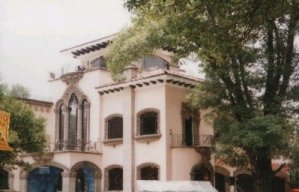RESHAPING TRADITION IN NORTH AMERICA
At the turn of the century, the world is experiencing a new globalization process that is changing many preceeding conceptions. At the same time that this process seems to be opening national economic and social borders, it is also creating new identities that are emerging giving rise to internal frontiers. In other words, the process of globalization tends to both minimize external frontiers and generate new interior borders that only communication and understanding can eliminate. In this context, what is going to happen to tradition in North American countries? Is it firmly grounded or we will see the creation of new traditions? Globalization will bring several consequences to our countries. One is the need for new definitions not only about our national identity but also about our neighboring nations.
In past years, analysis, research and financial resources, have been dedicated to study aspects such as politics, economy and commerce. Those activities, have grown in importance in order to make businesses and communications work, while, studies about societal behavior and the cultural heritage that defines our societies have been left aside. We have to make them grow and borderland studies can become an activity that can contribute to the expansion of its importance. Knowing about a nation's cultural context will allow people to understand diversity, comprehend internal and external differences and similarities, and it will give them the opportunity to know how they are seen from the exterior. Understanding the idea that outsiders have about us could be a incentive to the reevaluation of national essence, past and heritage, and may open a new possibility of transforming, and reshaping tradition in order to create a new American common future. In this process neighbor's observation and opinions will have a special meaning.
The Mexican and United States border is a privileged site to watch, analyze and evaluate the encounter of two nation's cultures and societies. The knowledge opf the Borderland regions will allow us to see both common influences and the evolution of a new and particular social and cultural community. Borderlands are a social laboratory where different versions of being American collude, collide, reject and attract themselves; it is a site where our neighbor's perception is closer, familiar and opposite all at the same time; it is a cultural experimenting place where global and national influences are taken, reshaped, and Americanized in a different way. The Borderland is, in a word, an space where external influences and internal traditions are regularly transformed.
Knowing and analyzing tradition in Mexico and the United States will give us a better understanding of our national history, our deepest dreams, our imagery and, more important, our thinking about the future. Seeing tradition as an antique house that has to be revitalized in order to accomplish new functions, and History as a tool to evaluate changes, constants and tendencies in the evolution of nations, thid knowledge will help us to explore coincidences and work together in the construction of a shared and common future. From this point of view, Borderland History is a tool for comprehending how societies transform, evolve through internal and external influences and from the point of view of outsiders, in order to create divers designs of the future.
RESHAPING EUROPEAN TRADITION IN NORTH AMERICAN URBAN STRUCTURE AND ARCHITECTURE
Since their origin as nations, urban platting and almost every architectural tradition has been redefined in American countries, creating an original expression of cities, and giving rise to the formation of a new tradition. From the first building erected in colonial Mexico, to the last one built in our Continent, Americans have shaped a specific Architecture. Native Americans together with a huge variety of immigrants with different backgrounds confronted with new natural context, labor conditions, construction materials and many other social and economic situations, they reshaped buildings, and therefore architectural styles and urban structures. European architectural and urban paradigms have experienced both common and specific responses in America. Although similar at first and sharing common origins, European influences took different forms in Mexico, United States and Canada. Architecture and urban context have been reshaped according to its particular old and new imagery and every nation's tradition has expressed a specific cultural background through it. Even when colonization came from the same Continent, new national characteristics gave each new American country's evolution a different ethnic integration, immigration policies, social and economic development. During the Nineteenth Century no new cities were created in Mexico to house new and mainly Spanish origin population. On the contrary, in the US, the most important cities of the West and Southwest were erected during that era in order to settle a multinational population.

Notwithstanding the fact that many exact copies were shipped from the original countries and built in America, this architecture was reshaped to some extent. In Mexico, although Spanish architectural and urban planning continued for many years, new population occupied, as first time owners, the most important suburbs with new side-by-side houses constructed with permanent materials. Meanwhile, in the US, all of the European architectural styles that came in the multicultural immigrant's imagery were adapted to a wide new territory, a highly mobile lifestyle, temporary land occupation and self-made construction.
Traditionally, architectural and urban influences had only been a matter of aesthetic analysis, evolution of styles and the study of master pieces. Now, architecture has become a topic for a interpretation of its cultural and social foundations, national evolution that will allow us a broad comprehension of history. Buildings and cities express differences and similarities as well as being landmarks of mutual influences and cultural affinities, they are a part of a living and historical social evolution that has changed or persisted in its behavior. Permanent and changing cultural backgrounds have posted their sign in the urban structure and architecture and look like museum's pieces in needed of a script that has to be written from the historical, cultural and societal point of view.
Mexico and the United States have had very important mutual social, political and cultural influences. After gaining ndependence, the conformation of North America countries implied a neighborhood of competing States that were later engaged in commercial and military rivalry, war and the creation of a borderland that brought isolation and misunderstanding between Mexico and United States. It took time to establish a new relationship and social, political and economic interaction.In Architecture, influences became important to both countries at the end of the Nineteenth Century and the beginning of the Twentieth, when some U. S. builders designed French style houses while others were attracted by Mexico's Spanish Colonial style and used them in new constructions particularly in Borderland cities of the United States. Later on, Mexican Architects brought that style back, after it had been reshaped in the States, giving birth to a new style named Colonial Californiano (Californian Spanish Colonial) that was used in many high and medium income land developments in Mexico.

The architecture and the urban structure in certain areas of the two countries (after those initial encounters) have had mutual influences that have been studied properly. Due to the importance of this analysis in the understanding of historical, cultural evolution and societal structure of both countries, my research will bring a particular point of view in the analysis and similarities between Mexico and the United States; it will contribute to evaluate urban and architectural changes and constants in the historical relationship between our countries as part of their evolution as nations; it will contribute to explore coincidences in order to make the construction of a shared and common future easier; it will introduce architectural and urban professional practice to the field of traditional environments and will allow us to examine its historical implications and its potential.